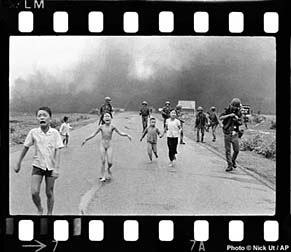|
How the Picture Reached
the World
by Horst Faas and Marianne Fulton
 The
photograph reached the newspapers around the world only after passing
through a gauntlet of human decisions and technical difficulties.
The technology used to produce and transmit the photograph appears
antique today. The
photograph reached the newspapers around the world only after passing
through a gauntlet of human decisions and technical difficulties.
The technology used to produce and transmit the photograph appears
antique today.
Nick Ut's eight rolls of Kodak 400
ASA black and white films were developed in the lab of the Saigon
AP office by the Japanese photographer ' Ishizaki Jackson', a known
AP Tokyo news photographer at this time. The development solutions
(Ilford Microfen developer and self-mixed fixative) were stored
in large food jars. Since the temperatures of the chemicals were
rarely below 30 degree centigrade the processing time was relatively
short and the film had to be slowly moved at all times, by hand,
like slow-motion laundering. The films were then dried in a special
cabinet with hairdryers rigged up and switched in a way as not to
damage could the swelling emulsion.
Nick and Ishizaki prepared a selection
of eight 5x7 inch prints for the next "radio photo cast" at 5 PM
- but an editor at the AP rejected the photo of Kim Phuc running
down the road without clothing because it showed frontal nudity.
Pictures of nudes of all ages and sexes, and especially frontal
views were an absolute no-no at the Associated Press in 1972. While
the argument went on in the AP bureau, writer Peter Arnett and Horst
Faas, then head of the Saigon photo department, came back from an
assignment. Horst argued by telex with the New York head-office
that an exception must be made, with the compromise that no close-up
of the girl Kim Phuc alone would be transmitted.
The New York photo editor, Hal Buell,
agreed that the news value of the photograph overrode any reservations
about nudity.
The photo was then electrically transmitted,
line by line, in 14 minutes, on a manually dialed radio-phone call
with a Muirhead K220 transmitter with a supplementary AM/FM converter.
AP had this equipment stationed next to the switchboard at the Saigon
PTT's (Post and Telegraph) telephone exchange in Saigon. The radio
conditions were favorable that day and the picture, along with three
other photographs of then incident reached the Tokyo photo bureau
of The Associated Press. From Tokyo the radio signal coming
from Saigon was auto-relayed on AP controlled land and submarine
wire communications circuits to New York and London, and from there
to AP offices and newspapers around the world.
AP's bureau chief Richard Pyle recalled
in an April 2000 interview that Horst Faas said "I think we have
another Pulitzer here" when he looked at Ut's film through his magnifying
glass in 1972. Horst added in the same interview: "It remains
one of the most perfect news photos I have seen in my fifty years
in photo journalism."
The Camera and Lens used by Nick
Ut for his Pulitzer winning photograph.
To shoot his Pulitzer prize winning
photograph Huynh Cong 'Nick Ut' used the Leica M-2 body with the
serial number 1923019 with a 35mm Summicron lens, serial number
1923019. It had not been AP's practice in 1972 to equip staff
photographers with the German-made Leitz (Leica) cameras and lenses.
Nikon equipment was the standard AP issue. However, every staff
photographer of AP in Vietnam, eventually used his "own Leica" equipment,
following the example of Horst Faas, who arrived in Vietnam
in June 1962 with his "own" Leica equipment coming from an assignment
in Algeria.
Expense accounts and some fudging
in the acquisition of "capital investments", i.e. cameras, lenses
etc., in Hong Kong or from the black market in Saigon helped the
photographers get their high-quality Leica cameras and lenses.
Nick Ut's elder brother, who died
in battle in October 1965 used, of course, a Leica camera. Thus
it was only natural that his little brother Ut eventually also had
his own Leica. When Nick Ut was evacuated from Vietnam at the end
of the war he took the camera and lens with him - and used both
until the late eighties. He only lost his 50mm Leica lens in the
hasty flight from Vietnam in 1975.
Other equipment used to shoot scenes
around the "Kim Phuc incident" included a Nikon F body, with 200mm,
300mm and a wide-angle lens.
The Leica and 35mm Summicron are today
exhibited at the Science Museum in London, along with Nick's pictures
and a wire photo drum transmitter of the Muirhead K220 type that
transmitted Ut's photographs from Saigon into the world on radio
waves.
A check with the Leitz archives in
Germany showed that Nick Ut's camera was produced in Germany in
1965.
|